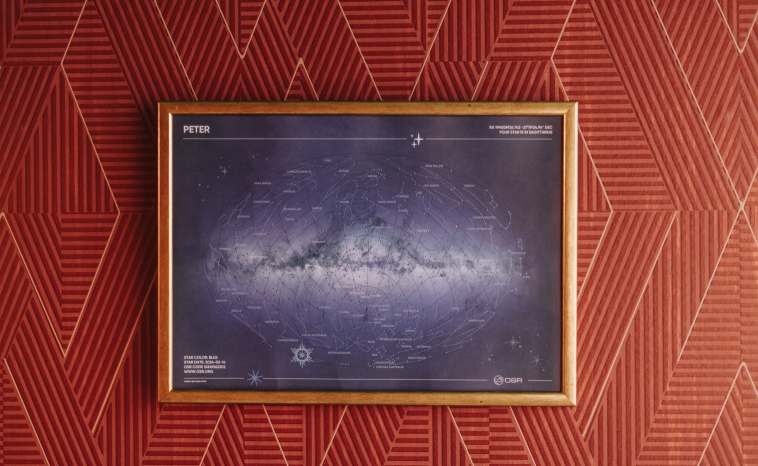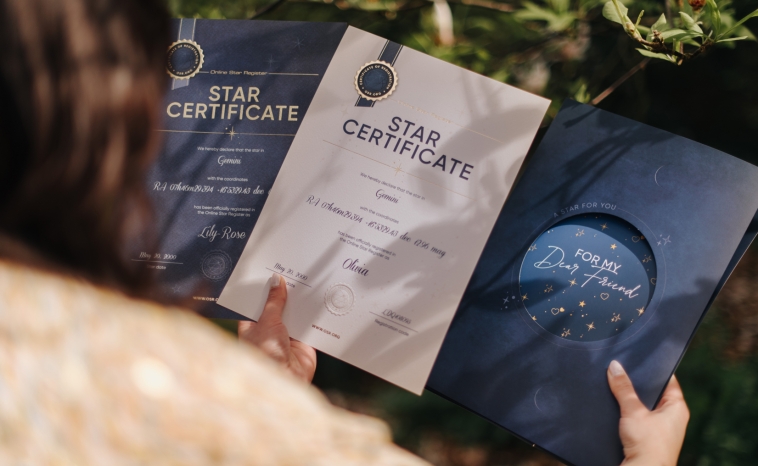How Can I Find My Star in the Night Sky?

If you’ve been lucky enough to receive one of our fantastic star gifts and you’re wondering “how do I find my star?”, then this is the article for you! Keep reading for all our top tips on locating your named star.
Have you ever wondered what it would be like to have a star named after you or a loved one? Thanks to the Online Star Register (OSR), this dream can become a shiny reality! But once you’ve received this wonderful celestial gift, you might be asking yourself, “How can I find my star?”.
Well, that’s where this article comes in! We’ll guide you on exactly how to locate your star using various methods, from star maps to modern apps, all while savoring the excitement of stargazing.
What is a Star Map?

A star map, also known as a star chart or sky map, is a graphical representation of the night sky. They serve as a valuable tool for both amateur stargazers and seasoned astronomers. Providing detailed information about various celestial bodies, like stars, constellations, planets, and other astronomical phenomena, they help users identify and locate these objects with ease.
Typically, star maps depict the position of stars as they appear from a specific location on Earth. They often include labels and symbols to represent different constellations and notable celestial features. For centuries, astronomers and navigators have relied on star maps not only to explore the heavens but also to aid in navigation and timekeeping, as the positions of stars have been crucial for understanding our place in the universe.
Find My Star With a Star Map
Star maps are an excellent starting point for any stargazer. And when you pick our Super Star Gift, you’ll receive our fantastic star map poster as part of your bundle, with your star already highlighted! But whichever star map you have, here’s how to use one to find your star:
- Get Your Coordinates Ready: When OSR registers your star, you’ll receive its exact coordinates. These coordinates are crucial for pinpointing your star’s location on a standard star map.
- Choose Your Star Map: Numerous star maps are available, ranging from traditional paper charts to digital versions. Websites like Stellarium and Sky & Telescope offer interactive star maps that you can customise to your location.
- Plot Your Star: Once you have your coordinates and star map, plot your star’s location. Look for its constellation and use the map’s grid to find the exact spot. It may take a bit of practice, but the satisfaction of locating your star is well worth the effort!
Find My Star With a Star Finding App

In today’s digital age, star-finding apps have revolutionised how we explore the cosmos. These apps use things like augmented reality (AR) and GPS technology to make stargazing accessible to everyone.
To get started, pick a star finding app to download. The OSR Star Finder App is a fantastic choice, designed specifically for locating named stars. Other popular options include SkyView, Star Walk, and Night Sky.
Once downloaded, it’s time to open the app and start tracking your star. If you’re using our Star Finder App, you can enter your star’s unique code to make locating it a piece of cake. Otherwise, you can enter your star’s coordinates to pinpoint its location. Then, it’s simply a matter of heading outside on a clear night and opening the app. Point your smartphone or tablet at the sky, and it will overlay the star map with real-time data. Your star will be highlighted, making it easy to spot.
Benefits of Using a Star Finding App
Star finding apps are incredibly user-friendly and convenient, allowing you to locate your star with minimal effort. They also provide additional information about a wide range of celestial objects, enhancing your overall stargazing experience.
Find My Star With Coordinates
If you prefer a more traditional approach, you can find your star using its celestial coordinates. This method requires a bit of astronomical knowledge, but it can be highly rewarding!
Celestial coordinates are similar to geographic coordinates on Earth. They consist of two values: right ascension (RA) and declination (Dec). Right ascension is comparable to longitude, while declination is akin to latitude. When you name a star with OSR, you’ll receive these coordinates on your star certificate.
Now, to find your star manually, you’ll need a telescope with an equatorial mount. This type of mount allows you to align the telescope with the celestial coordinate system. First, align your telescope with the North Star (Polaris) to ensure accurate tracking. Then, use the RA and Dec settings to locate your star’s coordinates. Adjust the telescope’s position until you spot your star.
Final Thoughts

Naming a star with OSR and finding it in the night sky is a unique and enchanting experience. It’s a gift that lasts a lifetime, creating memories that shine as brightly as the stars themselves. Using a star map, a star-finding app, or celestial coordinates, the journey of discovery is a fascinating one. So, whether you’re an astronomy enthusiast, a stargazer, or simply someone curious about the universe, the joy of discovering your star awaits. Happy stargazing!

